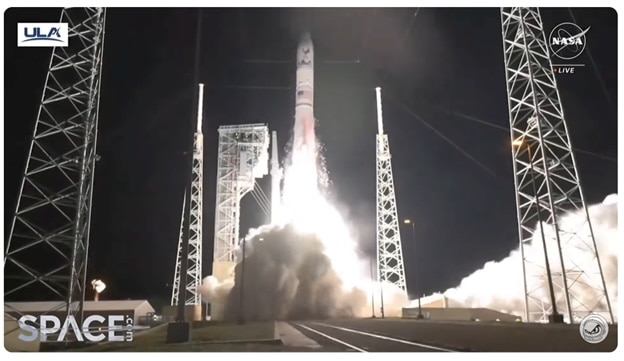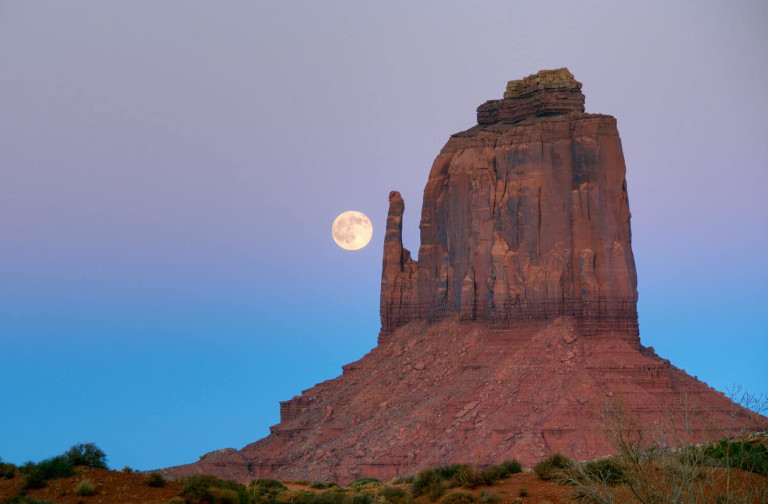This story was originally published by Barn Raiser, your independent source for rural and small town news.
Indigenous leaders accuse NASA of using a loophole to bypass promises made to Native nations
An ambitious public-private partnership has ushered in a new space race to the moon. But tribal nations warn that the rush for lunar development bodes poorly for the moon—and the Earth.
On February 22, a robotic lander named Odysseus became the first U.S. vehicle to land on the moon in more than 50 years. Intuitive Machines, which built and operated Odysseus, is one of 14 companies hired by NASA under a program known as Commercial Lunar Payload Services, or CLPS, which allows private companies to bid on NASA contracts worth a total of $2.6 billion through 2028 to launch and land moon missions, manage onboard payloads and carry out scientific experiments. Through the program, NASA claims it is supporting new science and growing the commercial space economy.
The inaugural moonshot was January 8, the first since the Apollo missions of the 1960s and ’70s. NASA paid United Launch Alliance, a Lockheed Martin–Boeing joint venture, $110 million to launch a moon lander by means of an unmanned Vulcan rocket. NASA had awarded another $108 million to Astrobotic Technology to develop the lander, which was loaded with $9 million’s worth of NASA scientific instruments designed to look for water on the moon, evaluate its soil and atmosphere and more.
NASA encourages payload service companies like Astrobotic Technology to make more money by selling available room on the flights to additional clients. The supplementary January 8 payloads included cremated human and animal remains from two space burial firms, Celestis and Elysium Space. (Having one’s ashes, or a pet’s, deposited on the moon is an upmarket vanity fad these days, costing upwards of $13,000.)
Say What?
Shortly before the January launch, two Indigenous groups—the Coalition of Large Tribes, or COLT, representing tribes with homelands encompassing more than 100,000 acres, along with the Navajo Nation, a member of the organization—wrote to NASA and the Department of Transportation, disturbed by what they’d heard about the burials.
“We view [the moon] as a part of our spiritual heritage, an object of reverence and respect,” wrote Navajo Nation president Buu Nygren. “The act of depositing human remains and other materials, which could be perceived as discards in any other location, on the Moon is tantamount to desecration of this sacred space.”
Even before the CLPS initiative, the Navajo Nation was on record objecting to such endeavors. In the late 1990s, the Navajo Nation’s then-president Albert Hale criticized NASA for transporting the ashes of scientist Eugene Shoemaker to the moon. At the time, NASA apologized and said it would consult with the tribe if such an act were planned again.
As part of the federal-tribal government-to-government relationship, the United States consults with tribal nations when projects will affect their interests. Even though the Biden administration reaffirmed this policy in 2022, COLT’s letter states that the January moon mission, with its payload of cremated remains, was “scheduled without tribal consultation” and should therefore have been canceled or at least postponed.
In a last-minute meeting convened by the White House two days before the launch, NASA reportedly told the tribes it didn’t have to consult with them because the flight wasn’t purely a NASA (that is, federal) mission. Yet NASA also describes itself as the primary client of the companies carrying it out.
OJ Semans, executive director of COLT and citizen of the Rosebud Sioux Nation, accuses NASA of speaking “with a forked tongue.” The moonshot was part of a NASA program, and NASA is part of the federal government, he says.
Navajo citizen Justin C. Ahasteen, executive director of the Navajo Nation’s Washington office, dismisses what he calls NASA’s attempt to identify a “loophole” to excuse the lack of consultation. “We take promises the federal government and its agencies make very seriously,” Ahasteen says, “and we do expect them to keep [those promises].”
The Navajo Nation supports space exploration, but not desecration, according to Ahasteen. In any case, he adds, NASA shouldn’t be squandering federal dollars by subsidizing vanity burials.
Charles Chafer, CEO of Celestis, a Houston-based space burial company involved in the mission, told CNN the Indigenous objections were “not substantive.” He said his firm’s moon memorial would be “handled with care and reverence … the exact opposite of desecration, it is a celebration.”

Liftoff of an unmanned United Launch Alliance Vulcan rocket from Cape Canaveral Space Force Station in Florida on January 8. (NASA)
The unmanned January 8 launch went ahead without tribal consultation. Within hours after liftoff, the moon lander developed serious fuel leaks, and the flight was described as “doomed.” The next day, NASA announced it would postpone upcoming crewed moon flights in order to “work through challenges.” On January 18, Astrobotic directed the crippled lander back toward Earth, where it burned up in the atmosphere along with the accompanying NASA instruments and human and pet remains.
(More mishaps: on February 22 the Intuitive Machines lander touched down sideways and as of press time is expected to stop working in the coming days.)
Sending remains to the moon may sound like an exciting idea, Ahasteen says, but “just because we can do it doesn’t mean that we should.” We must be sensitive to not just Native American culture but also other cultures around the globe, he says: “I am not aware of any religion in the world that says, ‘Send your loved ones to the moon.’”
Dig It!
The billions NASA plans to spend on lunar launch, landing and exploration services over the next few years may sound like a lot of money, but that sum exists in the context of what NASA trumpets as the upcoming “lunar gold rush.” The moon’s abundant resources include rare earth elements used in computers, cellphones, rechargeable batteries and many more devices; helium-3, a potential fuel for nuclear fusion; and water to sustain life or even be converted into hydrogen and oxygen for rocket fuel.
The U.S. is not the only nation lusting after those valuable commodities. Spacecrafts from Russia, China, India and Japan have also landed on and/or crashed into the moon in a sprint for its resources.
Little constrains what they might do next. The United Nations 1967 Outer Space Treaty contains vague language saying, for example, that outer space “is not subject to” nations’ claims of sovereignty. The Treaty doesn’t forbid, or even discourage, claims by the commercial companies increasingly involved in space exploration. Furthermore, the Treaty and the related documents that followed it establish no overseeing judicial body or enforcement mechanism for space activities.
Even worse, fewer nations agreed to each document than had acquiesced to the preceding one. Though 112 nations approved the 1967 Outer Space Treaty, a smaller number of countries agreed to the next three, according to the U.N. Committee on the Peaceful Uses of Outer Space. Just 18 approved the 1979 Moon Treaty, and the U.S. was not one of them.
What does Semans think of the treaties? “We’ve done that,” he answers. “It didn’t work out too well.”
And what does he say about recent stock-analyst recommendations to invest in shares of the space exploration companies? “Our motto should be ‘In Greed We Trust,’” Semans responds.
Some of the practices we’ve developed here on Earth may not bode well for the moon. Rare earth elements are known to be difficult to mine and purify, producing mountains of toxic waste, according to the Harvard International Review. Mining for rare earth elements and other minerals in the U.S. has long been fiercely destructive to the landscape. The Environmental Protection Agency calls mining “the single largest source of toxic waste in the United States,” contaminating 40% of Western waters.
We don’t know whether the moon’s fragile environment, including its very thin atmosphere, can withstand a fraction of that kind of pollution, attorney William B. Altabef wrote in 2021 in the Chicago Journal of International Law. So far, our home planet has largely withstood vast contamination and alteration. Altabef cautions that our celestial neighbor might not be as durable.
Damaging the moon could harm the Earth, Ahasteen warns. We count on its gravitational pull to regulate the oceans’ tides, he points out. That pull also stabilizes Earth’s tendency to wobble on its axis, according to the U.K.-based Institute of Physics. An unsteady Earth could experience climate change that makes today’s variations barely perceptible in comparison, suggests the institute.
Ahasteen urges further dialogue about sensible, well-considered space exploration. He hopes the U.S. will engage the tribes in a policy discussion “to promote scientific exploration but do it responsibly.”
Indigenous people have always been the conscience of the nation, according to Semans. The Lakota expression mitakuye oyasin means “all our relatives,” he says. This does not refer to just humans, he explains: “It’s everything. It’s the trees, it’s the grass, it’s the moon, it’s the sun. All these things provide our life. Without any of this, we wouldn’t exist.”





